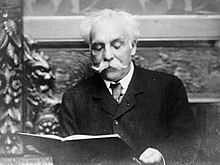Masques et bergamasques (Fauré)
| Masques et bergamasques | |
|---|---|
| by Gabriel Fauré | |

The composer in 1907
|
|
| Catalogue | Op. 112 |
| Related | Mostly based on earlier pieces, including Clair de lune and Pavane |
| Based on | Fêtes galantes of the 18th century |
| Composed | 1919 |
| Movements |
|
| Scoring |
|
Masques et bergamasques, Op. 112, is a twentieth-century musical homage to the world of the fêtes galantes of the eighteenth century by the French composer, organist, and choirmaster Gabriel Fauré (1845–1924).
Written quite late in Fauré's life, Masques et bergamasques is commonly heard today as an orchestral suite. However, the work arose under unusual circumstances. It was originally designed as incidental music to accompany a one-act divertissement, a danced-and-sung entertainment, with a scenario by René Fauchois inspired by the poet Paul Verlaine. The divertissement was about how members of a commedia dell'arte troupe would spy on the amorous encounters of aristocrats in its audience.
The work was commissioned by Albert I, Prince of Monaco and was first performed in Monte Carlo on 10 April 1919. The eight movements were almost all drawn from earlier works of Fauré:
The title, Masques et bergamasques (meaning "masks and bergamasks", a bergamask being a rustic dance), comes from the opening lines of the Verlaine poem sung as the sixth movement: "Votre âme est un paysage choisi / Que vont charmant masques et bergamasques." Fauré reportedly said of Masques et bergamasques that "it is like the impression you get from the paintings of Watteau."
The suite drawn from the work has remained one of Fauré's most popular works, and consists of four of the purely orchestral movements:
The Gavotte may be played before the Menuet. The entire piece runs about 14½ minutes.
...
Wikipedia
